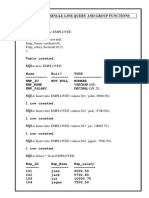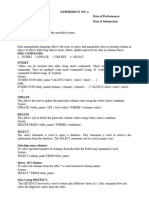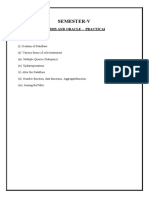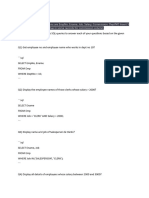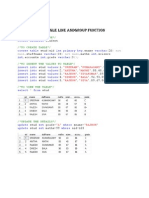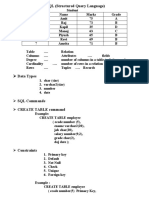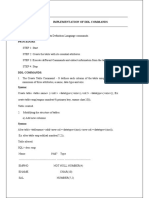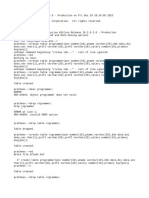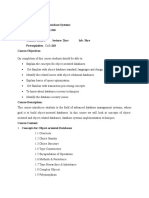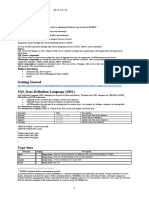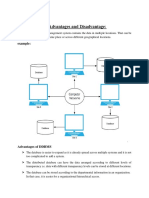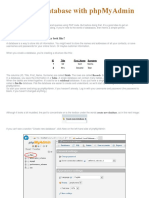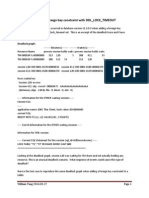Oracle
Uploaded by
msgaming6397Oracle
Uploaded by
msgaming6397SEMESTER: INDEX Batch:
ORACLE LAB
Sl. Page
No. Date Name of the Program Staff Sign
No.
SQL & PL/SQL
1 Table Creation with Simple Queries
Constraints [Primary Key, Foreign Key,
2
NOT NULL, Referential Integrity]
3 Joins [Left, Right and Equi Joins]
4 Sub Queries
Built-In-Functions [Date & Time,
5
Mathematical Functions]
6 Procedures
7 Functions
8 Functions with Exception Handling
9 Cursors
10 Triggers
Perform the Following Using VB as Front End and Oracle as Back End
Library Management System
11 [ADODCConnection]
Employee Details for IT Company
12 [ADODC Connection]
Hospital Management System
13 [ADODCConnection]
Remarks: Completed Programs
PageNo:
Ex.No: Table Creation with Simple Queries
Date:
AIM:-
Procedure:-
EX. NO : 1 TABLE CREATION AND SIMPLE QUERIES
SQL> create table stud(sno number(5),sname varchar2(25),class varchar2(10),mark1
number(5),mark2 number(5),mark3 number(5),mark4 number(5),mark5 number(5));
Table created.
SQL>desc stud;
Name Null? Type
SNO NUMBER(5)
SNAME VARCHAR2(25)
CLASS VARCHAR2(10)
MARK1 NUMBER(5)
MARK2 NUMBER(5)
MARK3 NUMBER(5)
MARK4 NUMBER(5)
MARK5 NUMBER(5)
SQL> insert into stud values(&sno,'&sname','&class',&mark1,&mark2,&mark3,&mark4,&mark5);
Enter value for sno: 1
Enter value for sname: ram
Enter value for class: bca
Enter value for mark1: 78
Enter value for mark2: 80
Enter value for mark3: 90
Enter value for mark4: 95
Enter value for mark5: 99
old 1: insert into stud values(&sno,'&sname','&class',&mark1,&mark2,&mark3,&mark4,&mark5)
new 1: insert into stud values(1,'ram','bca',78,80,90,95,99)
1 row created.
SQL> /
Enter value for sno: 2
Enter value for sname: suresh
Enter value for class: bsc
Enter value for mark1: 89
Enter value for mark2: 78
Enter value for mark3: 90
Enter value for mark4: 95
Enter value for mark5: 87
old 1: insert into stud values(&sno,'&sname','&class',&mark1,&mark2,&mark3,&mark4,&mark5)
new 1: insert into stud values(2,'suresh','bsc',89,78,90,95,87)
1 row created.
SQL> /
Enter value for sno: 3
Enter value for sname: arun
Enter value for class: bba
Enter value for mark1: 35
Enter value for mark2: 45
Enter value for mark3: 56
Enter value for mark4: 46
Enter value for mark5: 47
old 1: insert into stud values(&sno,'&sname','&class',&mark1,&mark2,&mark3,&mark4,&mark5)
new 1: insert into stud values(3,'arun','bba',35,45,56,46,47)
1 row created.
SQL> /
Enter value for sno: 4
Enter value for sname: raj
Enter value for class: b.com
Enter value for mark1: 78
Enter value for mark2: 67
Enter value for mark3: 90
Enter value for mark4: 89
Enter value for mark5: 79
old 1: insert into stud values(&sno,'&sname','&class',&mark1,&mark2,&mark3,&mark4,&mark5)
new 1: insert into stud values(4,'raj','b.com',78,67,90,89,79)
1 row created.
SQL> /
Enter value for sno: 5
Enter value for sname: mani
Enter value for class: ba
Enter value for mark1: 78
Enter value for mark2: 90
Enter value for mark3: 99
Enter value for mark4: 89
Enter value for mark5: 98
old 1: insert into stud values(&sno,'&sname','&class',&mark1,&mark2,&mark3,&mark4,&mark5)
new 1: insert into stud values(5,'mani','ba',78,90,99,89,98)
1 row created.
SQL> select * from stud;
SNO SNAME CLASS MARK1 MARK2 MARK3 MARK4 MARK 5
1 ram bca 78 80 90 95 99
2 suresh bsc 89 78 90 95 87
3 arun bba 35 45 56 46 47
4 raj b.com 78 67 90 89 79
5 mani ba 78 90 99 89 98
SQL> alter table stud add(total number(10),average number(10,2),result varchar2(4),grade
varchar2(2));
Table altered.
SQL>desc stud;
Name Null? Type
SNO NUMBER(5)
SNAME VARCHAR2(25)
CLASS VARCHAR2(10)
MARK1 NUMBER(5)
MARK2 NUMBER(5)
MARK3 NUMBER(5)
MARK4 NUMBER(5)
MARK5 NUMBER(5)
TOTAL NUMBER(10)
AVERAGE NUMBER(10,2)
RESULT VARCHAR2(4)
GRADE VARCHAR2(2)
SQL> update stud set total=mark1+mark2+mark3+mark4+mark5;
5 rows updated.
SQL> update stud set average=total/5;
5 rows updated.
SQL> update stud set result='pass' where mark1>=40 and mark2>=40 and mark3>=40 and
mark4>=40 and mark5>=40;
4 rows updated.
SQL> update stud set result='fail' where mark1<40 or mark2<40 or mark3<40 or mark4<40 or
mark5<40;
1 row updated.
SQL> update stud set grade='a' where average>=90;
1 row updated.
SQL> update stud set grade='b' where average>=75 and average<=89.9;
3 rows updated.
SQL> update stud set grade='c' where average>=50 and average<=74.9;
0 rows updated.
SQL> update stud set grade='d' where average<=49.9;
1 row updated.
SQL> select * from stud;
SNO SNAME CLASS MARK1 MARK2 MARK3 MARK4 MARK5 TOTAL AVERA RESU GR
-
1 ram bca 78 80 90 95 99 442 88.4 pass b
2 suresh bsc 89 78 90 95 87 439 87.8 pass b
3 arun bba 35 45 56 46 47 229 45.8 fail d
4 raj b.com 78 67 90 89 79 403 80.6 pass b
5 mani ba 78 90 99 89 98 454 90.8 pass a
SQL>savepoint s1;
Savepoint created.
SQL> delete from stud where sno=5;
1 row deleted.
SQL> select * from stud;
SNO SNAME CLASS MARK1 MARK2 MARK3 MARK4 MARK5 TOTAL AVERA RESU GR
-
1 ram bca 78 80 90 95 99 442 88.4 pass b
2 suresh bsc 89 78 90 95 87 439 87.8 pass b
3 arun bba 35 45 56 46 47 229 45.8 fail d
4 raj b.com 78 67 90 89 79 403 80.6 pass b
SQL> rollback to s1;
Rollback complete.
SQL> select * from stud;
SNO SNAME CLASS MARK1 MARK2 MARK3 MARK4 MARK5 TOTAL AVERA RESU GR
-
1 ram bca 78 80 90 95 99 442 88.4 pass b
2 suresh bsc 89 78 90 95 87 439 87.8 pass b
3 arun bba 35 45 56 46 47 229 45.8 fail d
4 raj b.com 78 67 90 89 79 403 80.6 pass b
5 mani ba 78 90 99 89 98 454 90.8 pass a
SQL> commit;
Commit complete.
SQL> drop table stud;
Table dropped.
Results
Ex.No:-02 Page No:
Date: Constraints [Primary Key, Foreign Key,
Not Null, Referential Integrity]
EX.NO : 2 CREATING TABLE WITH CONSTRAINTS
(NOT NULL)
SQL> create table stud(rollno number(5) not null,name varchar2(25),branch varchar2(10));
Table created.
SQL> desc stud;
Name Null? Type
ROLLNO NOT NULL NUMBER(5)
NAME VARCHAR2(25)
BRANCH VARCHAR2(10)
SQL> insert into stud values(&rollno,'&name','&branch');
Enter value for rollno: 101
Enter value for name: ram
Enter value for branch: cse
old 1: insert into stud values(&rollno,'&name','&branch')
new 1: insert into stud values(101,'ram','cse')
1 row created.
SQL> /
Enter value for rollno: 102
Enter value for name: abishek
Enter value for branch: cse
old 1: insert into stud values(&rollno,'&name','&branch')
new 1: insert into stud values(102,'abishek','cse')
1 row created.
SQL> select * from stud;
ROLLNO NAME BRANCH
101 ram cse
102 abishek cse
SQL> insert into stud values(&rollno,'&name','&branch');
Enter value for rollno:
Enter value for name: suresh
Enter value for branch: cse
old 1: insert into stud values(&rollno,'&name','&branch')
new 1: insert into stud values(,'suresh','cse')
insert into stud values(,'suresh','cse')
ERROR : CONNOT INSERT NULL INTO(“SCOTT”,’STUD’,ROLLNO)
(UNIQUE)
SQL> create table stud(rollno number(25) unique,name varchar2(25),branch varchar2(10));
Table created.
SQL> insert into stud values(&rollno,'&name','&branch');
Enter value for rollno: 1
Enter value for name: ram
Enter value for branch: cse
old 1: insert into stud values(&rollno,'&name','&branch')
new 1: insert into stud values(1,'ram','cse')
1 row created.
SQL> /
Enter value for rollno: 2
Enter value for name: suresh
Enter value for branch: cse
old 1: insert into stud values(&rollno,'&name','&branch')
new 1: insert into stud values(2,'suresh','cse')
1 row created.
SQL> /
Enter value for rollno: 2
Enter value for name: ganesh
Enter value for branch: cse
old 1: insert into stud values(&rollno,'&name','&branch')
new 1: insert into stud values(2,'ganesh','cse')
insert into stud values(2,'ganesh','cse')
ERROR at line 1:
ORA-00001: unique constraint (SCOTT.SYS_C003007) violated
(PRIMARY KEY)
SQL> create table stud(rollno number(5) primary key,name varchar2(25),branch varchar2(10));
Table created.
SQL> insert into stud values(&rollno,'&name','&branch');
Enter value for rollno: 1
Enter value for name: govind
Enter value for branch: mca
old 1: insert into stud values(&rollno,'&name','&branch')
new 1: insert into stud values(1,'govind','mca')
1 row created.
SQL> /
Enter value for rollno: 2
Enter value for name: parthi
Enter value for branch: mca
old 1: insert into stud values(&rollno,'&name','&branch')
new 1: insert into stud values(2,'parthi','mca')
1 row created.
SQL> /
Enter value for rollno: 2
Enter value for name: rajan
Enter value for branch: mca
old 1: insert into stud values(&rollno,'&name','&branch')
new 1: insert into stud values(2,'rajan','mca')
insert into stud values(2,'rajan','mca')
ERROR at line 1:
ORA-00001: unique constraint (SCOTT.SYS_C003008) violated
SQL> /
Enter value for rollno:
Enter value for name: rajan
Enter value for branch: mca
old 1: insert into stud values(&rollno,'&name','&branch')
new 1: insert into stud values(,'rajan','mca')
insert into stud values(,'rajan','mca')
*
ERROR : CONNOT INSERT NULL INTO(“SCOTT”,’STUD’,ROLLNO)
SQL> select * from stud;
ROLLNO NAME BRANCH
1 govind mca
2 parthi mca
(FOREIGN KEY)
SQL> create table admin(id number(5) constraint id_pk primary key,name varchar2(25),percentage
number(5));
Table created.
SQL> insert into admin values(&id,'&name',&percentage);
Enter value for id: 1
Enter value for name: arun
Enter value for percentage: 75
old 1: insert into admin values(&id,'&name',&percentage)
new 1: insert into admin values(1,'arun',75)
1 row created.
SQL> /
Enter value for id: 2
Enter value for name: bala
Enter value for percentage: 90
old 1: insert into admin values(&id,'&name',&percentage)
new 1: insert into admin values(2,'bala',90)
1 row created.
SQL> /
Enter value for id: 3
Enter value for name: hari
Enter value for percentage: 60
old 1: insert into admin values(&id,'&name',&percentage)
new 1: insert into admin values(3,'hari',60)
1 row created.
SQL> /
Enter value for id: 4
Enter value for name: ramesh
Enter value for percentage: 90
old 1: insert into admin values(&id,'&name',&percentage)
new 1: insert into admin values(4,'ramesh',90)
1 row created.
SQL> /
Enter value for id: 5
Enter value for name: murugan
Enter value for percentage: 89
old 1: insert into admin values(&id,'&name',&percentage)
new 1: insert into admin values(5,'murugan',89)
1 row created.
SQL> select * from admin;
ID NAME PERCENTAGE
1 arun 75
2 bala 90
3 hari 60
4 ramesh 90
5 murugan 89
SQL> create table course(id number(5) constraint id_fk references admin(id),branch varchar2(10),sect
ion varchar2(5));
Table created.
SQL> insert into course values(&id,'&branch','§ion');
Enter value for id: 1
Enter value for branch: cse
Enter value for section: a
old 1: insert into course values(&id,'&branch','§ion')
new 1: insert into course values(1,'cse','a')
1 row created.
SQL> /
Enter value for id: 6
Enter value for branch: cse
Enter value for section: b
old 1: insert into course values(&id,'&branch','§ion')
new 1: insert into course values(6,'cse','b')
insert into course values(6,'cse','b')
ERROR at line 1:
ORA-02291: integrity constraint (SCOTT.ID_FK) violated - parent key not found
SQL> delete from admin where id=1;
delete from admin where id=1
ERROR at line 1:
ORA-02292: integrity constraint (SCOTT.ID_FK) violated - child record found
SQL> delete from course where id=1;
1 row deleted.
SQL> delete from admin where id=1;
1 row deleted.
SQL> select * from admin;
ID NAME PERCENTAGE
2 bala 90
3 hari 60
4 ramesh 90
5 murugan 89
Result:
Ex.No: 03 JOINS Page No:
Date:
AIM:-
Procedure:-
EX. NO: 3 JOINS
SQL> create table emp3(id number(5),name varchar2(25),designation varchar2(20));
Table created.
SQL> insert into emp3 values(&id,'&name','&designation');
Enter value for id: 1
Enter value for name: ram
Enter value for designation: manager
old 1: insert into emp3 values(&id,'&name','&designation')
new 1: insert into emp3 values(1,'ram','manager')
1 row created.
SQL> /
Enter value for id: 2
Enter value for name: arun
Enter value for designation: programmer
old 1: insert into emp3 values(&id,'&name','&designation')
new 1: insert into emp3 values(2,'arun','programmer')
1 row created.
SQL> /
Enter value for id: 3
Enter value for name: sathish
Enter value for designation: programmer
old 1: insert into emp3 values(&id,'&name','&designation')
new 1: insert into emp3 values(3,'sathish','programmer')
1 row created.
SQL> /
Enter value for id: 4
Enter value for name: guna
Enter value for designation: designer
old 1: insert into emp3 values(&id,'&name','&designation')
new 1: insert into emp3 values(4,'guna','designer')
1 row created.
SQL> /
Enter value for id: 5
Enter value for name: govind
Enter value for designation: designer
old 1: insert into emp3 values(&id,'&name','&designation')
new 1: insert into emp3 values(5,'govind','designer')
1 row created.
SQL> create table package(id number(5),salary number(10));
Table created.
SQL> insert into package values(&id,&salary);
Enter value for id: 1
Enter value for salary: 50000
old 1: insert into package values(&id,&salary)
new 1: insert into package values(1,50000)
1 row created.
SQL> /
Enter value for id: 3
Enter value for salary: 30000
old 1: insert into package values(&id,&salary)
new 1: insert into package values(3,30000)
1 row created.
SQL> /
Enter value for id: 5
Enter value for salary: 30000
old 1: insert into package values(&id,&salary)
new 1: insert into package values(5,30000)
1 row created.
(LEFT JOIN)
SQL> select emp3.id,emp3.name,package.salary from emp3 left join package on emp3.id=package.id;
ID NAME SALARY
1 ram 50000
3 sathish 30000
5 govind 30000
4 guna
2 arun
(RIGHT JOIN)
SQL> select emp3.id,emp3.name,package.salary from emp3 right join package on
emp3.id=package.id;
ID NAME SALARY
1 ram 50000
3 sathish 30000
5 govind 30000
(EQUI JOIN)
SQL> select emp3.id,emp3.name,package.salary from emp3,package where emp3.id=package.id;
ID NAME SALARY
1 ram 50000
3 sathish 30000
5 govind 30000
Result:-
Ex.No 04 SUB QUERIES Page No:
Date:
AIM:-
Procedure:-
EX. NO: 4 SUB QUERIES
SQL> create table emp4(id number(5),name varchar2(25),job varchar2(15),salary
number(10),dept_no number(5));
Table created.
SQL> insert into emp4 values(&id,'&name','&job',&salary,&dept_no);
Enter value for id: 1
Enter value for name: ram
Enter value for job: manager
Enter value for salary: 50000
Enter value for dept_no: 101
old 1: insert into emp4 values(&id,'&name','&job',&salary,&dept_no)
new 1: insert into emp4 values(1,'ram','manager',50000,101)
1 row created.
SQL> /
Enter value for id: 2
Enter value for name: arun
Enter value for job: clerk
Enter value for salary: 15000
Enter value for dept_no: 103
old 1: insert into emp4 values(&id,'&name','&job',&salary,&dept_no)
new 1: insert into emp4 values(2,'arun','clerk',15000,103)
1 row created.
SQL> /
Enter value for id: 3
Enter value for name: suresh
Enter value for job: clerk
Enter value for salary: 17000
Enter value for dept_no: 103
old 1: insert into emp4 values(&id,'&name','&job',&salary,&dept_no)
new 1: insert into emp4 values(3,'suresh','clerk',17000,103)
1 row created.
SQL> /
Enter value for id: 4
Enter value for name: raghu
Enter value for job: salesman
Enter value for salary: 10000
Enter value for dept_no: 104
old 1: insert into emp4 values(&id,'&name','&job',&salary,&dept_no)
new 1: insert into emp4 values(4,'raghu','salesman',10000,104)
1 row created.
SQL> /
Enter value for id: 5
Enter value for name: govind
Enter value for job: analyst
Enter value for salary: 15000
Enter value for dept_no: 103
old 1: insert into emp4 values(&id,'&name','&job',&salary,&dept_no)
new 1: insert into emp4 values(5,'govind','analyst',15000,103)
1 row created.
SQL> /
Enter value for id: 6
Enter value for name: parthi
Enter value for job: president
Enter value for salary: 20000
Enter value for dept_no: 102
old 1: insert into emp4 values(&id,'&name','&job',&salary,&dept_no)
new 1: insert into emp4 values(6,'parthi','president',20000,102)
1 row created.
SQL> create table dept1(dept_no number(5),dname varchar2(25),loc varchar2(15));
Table created.
SQL> insert into dept1 values(&dept_no,'&dname','&loc');
Enter value for dept_no: 101
Enter value for dname: sales
Enter value for loc: canada
old 1: insert into dept1 values(&dept_no,'&dname','&loc')
new 1: insert into dept1 values(101,'sales','canada')
1 row created.
SQL> /
Enter value for dept_no: 102
Enter value for dname: acconting
Enter value for loc: newyork
old 1: insert into dept1 values(&dept_no,'&dname','&loc')
new 1: insert into dept1 values(102,'acconting','newyork')
1 row created.
SQL> /
Enter value for dept_no: 103
Enter value for dname: research
Enter value for loc: dallas
old 1: insert into dept1 values(&dept_no,'&dname','&loc')
new 1: insert into dept1 values(103,'research','dallas')
1 row created.
SQL> /
Enter value for dept_no: 104
Enter value for dname: operations
Enter value for loc: boston
old 1: insert into dept1 values(&dept_no,'&dname','&loc')
new 1: insert into dept1 values(104,'operations','boston')
1 row created.
SQL> /
Enter value for dept_no: 105
Enter value for dname: executive
Enter value for loc: landon
old 1: insert into dept1 values(&dept_no,'&dname','&loc')
new 1: insert into dept1 values(105,'executive','landon')
1 row created.
SQL> select * from emp4;
ID NAME JOB SALARY DEPT_NO
1 ram manager 50000 101
2 arun clerk 15000 103
3 suresh clerk 17000 103
4 raghu salesman 10000 104
5 govind analyst 15000 103
6 parthi president 20000 102
6 rows selected.
SQL> select * from dept1;
DEPT_NO DNAME LOC
101 sales canada
102 acconting newyork
103 research dallas
104 operations boston
105 executive landon
(IN)
SQL> select * from emp4 where salary in(15000,25000);
ID NAME JOB SALARY DEPT_NO
2 arun clerk 15000 103
5 govind analyst 15000 103
SQL> select * from emp4 where salary in(select max(salary) from emp4);
ID NAME JOB SALARY DEPT_NO
1 ram manager 50000 101
SQL> select * from emp4 where salary in(select max(salary) from emp4 group by dept_no);
ID NAME JOB SALARY DEPT_NO
-
4 raghu salesman 10000 104
3 suresh clerk 17000 103
6 parthi president 20000 102
1 ram manager 50000 101
(ALL)
SQL> select * from emp4 where salary>all(dept_no);
ID NAME JOB SALARY DEPT_NO
1 ram manager 50000 101
2 arun clerk 15000 103
3 suresh clerk 17000 103
4 raghu salesman 10000 104
5 govind analyst 15000 103
6 parthi president 20000 102
6 rows selected.
(ANY)
SQL> select * from emp4 where salary>any(select salary from emp4 where job='clerk');
ID NAME JOB SALARY DEPT_NO
1 ram manager 50000 101
3 suresh clerk 17000 103
6 parthi president 20000 102
SQL> select * from emp4 where salary<any(select salary from emp4 where job='clerk');
ID NAME JOB SALARY DEPT_NO
2 arun clerk 15000 103
4 raghu salesman 10000 104
5 govind analyst 15000 103
SQL> select * from emp4 where salary=any(select salary from emp4 where job='clerk');
ID NAME JOB SALARY DEPT_NO
2 arun clerk 15000 103
5 govind analyst 15000 103
3 suresh clerk 17000 103
(EXISTS)
SQL> select dept_no,dname from dept1 d where exists(select * from emp4 e where
e.dept_no=d.dept_no);
DEPT_NO DNAME
101 sales
102 acconting
103 research
104 operations
(NOT EXISTS)
SQL> select dept_no,dname from dept1 d where not exists(select * from emp4 e where
e.dept_no=d.dept_no);
DEPT_NO DNAME
105 executive
(UNION)
SQL> select dept_no from emp4 union select dept_no from dept1;
DEPT_NO
101
102
103
104
105
(INTERSECT)
SQL> select dept_no from emp4 intersect select dept_no from dept1;
DEPT_NO
101
102
103
104
(MINUS)
SQL> select dept_no from emp4 minus select dept_no from dept1;
no rows selected
SQL> select dept_no from dept1 minus select dept_no from emp4;
DEPT_NO
105
Result
Ex.No:05 BUILT-IN-FUNCTIONS Page No:
EX. NO: 5 BUILT-IN-FUNCTIONS
DATE AND TIME FUNCTIONS
SQL> select sysdate from dual;
SYSDATE
16-JUL-08
SQL> select sysdate,add_months(sysdate,4) result from dual;
SYSDATE RESULT
16-JUL-08 16-NOV-08
SQL> select sysdate, last_day(sysdate) result from dual;
SYSDATE RESULT
16-JUL-08 31-JUL-08
SQL> select sysdate, next_day(sysdate,'sunday') result from dual;
SYSDATE RESULT
16-JUL-08 20-JUL-08
SQL> select months_between('09-aug-91','11-mar-90') result from dual;
RESULT
16.935484
SQL> select least(’10-jan-14’,’12-feb-14’) result from dual;
RESULT
10-jan-14
SQL> select greatest('10-jan-14','12-feb-14') result from dual;
RESULT
12-feb-14
SQL> select to_char(sysdate,'dd-mon-yyyy') result from dual;
RESULT
12-feb-14
SQL> select sessiontimezone, current_date from dual;
SESSIONTIMEZONE CURRENT_DATE
+00:00 20-SEP-2014
SQL> select sessiontimezone from dual;
SESSIONTIMEZONE
+00:00
NUMERIC FUNCTIONS
SQL> select round(12.36),round(14.63) from dual;
ROUND(12.36) ROUND(14.63)
12 15
SQL> select floor(12.87),floor(11.23) from dual;
FLOOR(12.87) FLOOR(11.23)
12 11
SQL> select ceil(16.23),ceil(12.8) from dual;
CEIL(16.23) CEIL(12.8)
17 13
SQL> select mod(11,4) from dual;
MOD(11,4)
SQL> select sign(0),sign(34),sign(-56) from dual;
SIGN(0) SIGN(34) SIGN(-56)
0 1 -1
SQL> select abs(15),abs(-90) from dual;
ABS(15) ABS(-90)
15 90
SQL> select abs(-20) result from dual;
RESULT
20
SQL> select power (2,10) result from dual;
RESULT
1024
SQL> select round(15.359,2) result from dual;
RESULT
15.36
SQL> select sqrt (36) result from dual;
RESULT
6
Results
Ex.No:06 PROCEDURES Page No
Date:
AIM:-
Procedure:-
EX. NO: 6 PROCEDURES
TO DISPLAY HELLO MESSAGE
SQL> set serveroutput on;
SQL> declare
2 a varchar2(20);
3 begin
4 a:='Hello';
5 dbms_output.put_line(a);
6 end;
7/
Hello
PL/SQL procedure successfully completed.
(CREATE ITEMS TABLE)
SQL> create table items(itemid number(3), actualprice number(5), ordid number(4), prodid
number(4));
Table created.
SQL> insert into items values(&itemid,&actualprice,&ordid,&prodid);
Enter value for itemid: 1
Enter value for actualprice: 5000
Enter value for ordid: 101
Enter value for prodid: 1001
old 1: insert into items values(&itemid,&actualprice,&ordid,&prodid)
new 1: insert into items values(1,5000,101,1001)
1 row created.
SQL> /
Enter value for itemid: 2
Enter value for actualprice: 6000
Enter value for ordid: 102
Enter value for prodid: 1002
old 1: insert into items values(&itemid,&actualprice,&ordid,&prodid)
new 1: insert into items values(2,6000,102,1002)
1 row created.
SQL> /
Enter value for itemid: 3
Enter value for actualprice: 7500
Enter value for ordid: 103
Enter value for prodid: 1003
old 1: insert into items values(&itemid,&actualprice,&ordid,&prodid)
new 1: insert into items values(3,7500,103,1003)
1 row created.
SQL> select * from items;
ITEMID ACTUALPRICE ORDID PRODID
1 5000 101 1001
2 6000 102 1002
3 7500 103 1003
PROCEDURE FOR ‘IN’ PARAMETER – CREATION, EXECUTION
SQL> set serveroutput on;
SQL> create procedure zzz (a IN number) is price number;
2 begin
3 select actualprice into price from items where itemid=a;
4 dbms_output.put_line('Actual price is ' || price);
5 if price is null then
6 dbms_output.put_line('price is null');
7 end if;
8 end;
9/
Procedure created.
SQL> exec zzz(2);
Actual price is 6000
PL/SQL procedure successfully completed.
PROCEDURE FOR ‘OUT’ PARAMETER – CREATION, EXECUTION
SQL> set serveroutput on;
SQL> create procedure ddd (a in number, b out number) is identity number;
2 begin
3 select ordid into identity from items where itemid=a;
4 if identity<1000 then
5 b:=100;
6 end if;
7 end;
8/
Procedure created.
SQL> declare
2 a number;
3 b number;
4 begin
5 ddd(1,b);
6 dbms_output.put_line('The value of b is '|| b);
7 end;
8/
The value of b is 100
PL/SQL procedure successfully completed.
PROCEDURE FOR ‘INOUT’ PARAMETER – CREATION, EXECUTION
SQL> set serveroutput on;
SQL> create procedure itit ( a in out number) is
2 begin
3 a:=a+1;
4 end;
5/
Procedure created.
SQL> declare
2 a number:=7;
3 begin
4 itit(a);
5 dbms_output.put_line('The updated value is ' ||a);
6 end;
7/
The updated value is 8
PL/SQL procedure successfully completed.
Result:
Ex.No:07 FUNCTIONS Page No:
Date:
AIM:-
Procedure:-
EX. NO: 7 FUNCTIONS
SQL> create table train ( tno number(10), tfare number(10));
Table created.
SQL> insert into train values(&tno,&tfare);
Enter value for tno: 12345
Enter value for tfare: 500
old 1: insert into train values(&tno,&tfare)
new 1: insert into train values(12345,500)
1 row created.
SQL> /
Enter value for tno: 12346
Enter value for tfare: 600
old 1: insert into train values(&tno,&tfare)
new 1: insert into train values(12346,600)
1 row created.
SQL> /
Enter value for tno: 12347
Enter value for tfare: 700
old 1: insert into train values(&tno,&tfare)
new 1: insert into train values(12347,700)
1 row created.
SQL> select * from train;
TNO TFARE
12345 500
12346 600
12347 700
PROGRAM FOR FUNCTION AND IT’S EXECUTION
SQL> create function aaa (trainnumber number) return number is
2 trainfunction train.tfare % type;
3 begin
4 select tfare into trainfunction from train where tno=trainnumber;
5 return(trainfunction);
6 end;
7/
Function created.
SQL> set serveroutput on;
SQL> declare
2 amt number;
3 begin
4 amt:=aaa (12345);
5 dbms_output.put_line('Train fare is Rs. '||amt);
6 end;
7/
Train fare is Rs. 500
PL/SQL procedure successfully completed.
FACTORIAL OF A NUMBER USING FUNCTION — PROGRAM AND EXECUTION
SQL> create function fact (a number) return number is
2 fact number:=1;
3 b number;
4 begin
5 b:=a;
6 while b>0
7 loop
8 fact:=fact*b;
9 b:=b-1;
10 end loop;
11 return(fact);
12 end;
13 /
Function created.
SQL> set serveroutput on;
SQL> declare
2 a number:=5;
3 f number(10);
4 begin
5 f:=fact(a);
6 dbms_output.put_line('The factorial of the given number is '||f);
7 end;
8/
The factorial of the given number is 120
PL/SQL procedure successfully completed.
Ex.No:08 FUNCTION WITH EXCEPTION HANDLING Page No:
Date:
AIM:-
Procedure:-
EX. NO: 8 FUNCTION WITH EXCEPTION HANDLING
USER DEFINED EXCEPTION
SQL> set serveroutput on;
SQL> DECLARE
2 quantity1 NUMBER := -2;
3 quantity2 NUMBER := 4;
4 total NUMBER := 0;
5 quantity_must_positive EXCEPTION;
6 FUNCTION find_cost (quant NUMBER) RETURN NUMBER IS
7 BEGIN
8 IF (quant > 0)
9 THEN
10 RETURN(quant * 20);
11 ELSE
12 RAISE quantity_must_positive;
13 END IF;
14 END find_cost;
15 BEGIN
16 total := find_cost (quantity2);
17 total := total + find_cost(quantity1);
18 EXCEPTION
19 WHEN quantity_must_positive
20 THEN
21 dbms_output.put_line('Total until now: ' || total);
22 dbms_output.put_line('Tried to use negative quantity ');
23 END;
24 /
Total until now: 80
Tried to use negative quantity
PL/SQL procedure successfully completed.
(CREATE ITEMS TABLE)
SQL> create table items(itemid number(3), actualprice number(5), ordid number(4), prodid
number(4));
Table created.
SQL> insert into items values(&itemid,&actualprice,&ordid,&prodid);
Enter value for itemid: 1
Enter value for actualprice: 5000
Enter value for ordid: 101
Enter value for prodid: 1001
old 1: insert into items values(&itemid,&actualprice,&ordid,&prodid)
new 1: insert into items values(1,5000,101,1001)
1 row created.
SQL> /
Enter value for itemid: 2
Enter value for actualprice: 6000
Enter value for ordid: 102
Enter value for prodid: 1002
old 1: insert into items values(&itemid,&actualprice,&ordid,&prodid)
new 1: insert into items values(2,6000,102,1002)
1 row created.
SQL> /
Enter value for itemid: 3
Enter value for actualprice: 7500
Enter value for ordid: 103
Enter value for prodid: 1003
old 1: insert into items values(&itemid,&actualprice,&ordid,&prodid)
new 1: insert into items values(3,7500,103,1003)
1 row created.
SQL> select * from items;
ITEMID ACTUALPRICE ORDID PRODID
1 5000 101 1001
2 6000 102 1002
3 7500 103 1003
PROGRAM FOR GENERAL PROCEDURE – SELECTED RECORD’S PRICE IS
INCREMENTED BY 1000 , EXECUTING THE PROCEDURE CREATED AND DISPLAYING
THE UPDATED TABLE
SQL> set serveroutput on;
SQL> create procedure itsum(identity number, total number) is price number;
2 null_price exception;
3 begin
4 select actualprice into price from items where itemid=identity;
5 if price is null then
6 raise null_price;
7 else
8 update items set actualprice=actualprice+total where itemid=identity;
9 end if;
10 exception
11 when null_price then
12 dbms_output.put_line('price is null');
13 end;
14 /
Procedure created.
SQL> exec itsum(1,1000);
PL/SQL procedure successfully completed.
SQL> select * from items;
ITEMID ACTUALPRICE ORDID PRODID
1 6000 101 1001
2 6000 102 1002
3 7500 103 1003
SQL> insert into items(itemid,ordid,prodid) values (&itemid,&ordid,&prodid);
Enter value for itemid: 4
Enter value for ordid: 104
Enter value for prodid: 1004
old 1: insert into items(itemid,ordid,prodid) values (&itemid,&ordid,&prodid)
new 1: insert into items(itemid,ordid,prodid) values (4,104,1004)
1 row created.
SQL> exec itsum(4,1000);
price is null
PRE DEFINED EXCEPTION
SQL> set serveroutput on;
SQL> declare
2 price ssitems.actualprice % type;
3 begin
4 select actualprice into price from ssitems where quantity=10;
5 exception
6 when no_data_found then
7 dbms_output.put_line ('ssitems missing');
8 end;
9/
ssitems missing
PL/SQL procedure successfully completed.
Result
EX. NO: 9 CURSORS
SQL> create table empp( eid number(10), ename varchar2(20), job varchar2(20), sal number
(10),deptno number(5));
Table created.
SQL> insert into empp values(&eid,'&ename','&job',&sal,&deptno);
Enter value for eid: 1
Enter value for ename: ram
Enter value for job: lecturer
Enter value for sal: 10000
Enter value for deptno: 11
old 1: insert into empp values(&eid,'&ename','&job',&sal,&deptno)
new 1: insert into empp values(1,'ram','lecturer',10000,11)
1 row created.
SQL> /
Enter value for eid: 2
Enter value for ename: suresh
Enter value for job: professor
Enter value for sal: 25000
Enter value for deptno: 12
old 1: insert into empp values(&eid,'&ename','&job',&sal,&deptno)
new 1: insert into empp values(2,'suresh','professor',25000,12)
1 row created.
SQL> /
Enter value for eid: 3
Enter value for ename: raghu
Enter value for job: lecturer
Enter value for sal: 11000
Enter value for deptno: 11
old 1: insert into empp values(&eid,'&ename','&job',&sal,&deptno)
new 1: insert into empp values(3,'raghu','lecturer',11000,11)
1 row created.
SQL> /
Enter value for eid: 4
Enter value for ename: govind
Enter value for job: professor
Enter value for sal: 30000
Enter value for deptno: 12
old 1: insert into empp values(&eid,'&ename','&job',&sal,&deptno)
new 1: insert into empp values(4,'govind','professor',30000,12)
1 row created.
SQL> /
Enter value for eid: 5
Enter value for ename: parthi
Enter value for job: lecturer
Enter value for sal: 12000
Enter value for deptno: 11
old 1: insert into empp values(&eid,'&ename','&job',&sal,&deptno)
new 1: insert into empp values(5,'parthi','lecturer',12000,11)
1 row created.
SQL> select * from empp;
EID ENAME JOB SAL DEPTNO
1 ram lecturer 10000 11
2 suresh professor 25000 12
3 raghu lecturer 11000 11
4 govind professor 30000 12
5 parthi lecturer 12000 11
TO WRITE A PL/SQL BLOCK TO DISPLAY THE EMPOYEE ID AND EMPLOYEE NAME
USING CURSOR FOR LOOP
SQL> set serveroutput on;
SQL> declare
2 begin
3 for emy in (select eid,ename from empp)
4 loop
5 dbms_output.put_line('Employee id and employee name are '|| emy.eid ||' and ' || emy.ename);
6 end loop;
7 end;
8/
Employee id and employee name are 1 and ram
Employee id and employee name are 2 and suresh
Employee id and employee name are 3 and raghu
Employee id and employee name are 4 and govind
Employee id and employee name are 5 and parthi
PL/SQL procedure successfully completed.
TO WRITE A PL/SQL BLOCK TO UPDATE THE SALARY OF ALL EMPLOYEES WHERE
DEPARTMENT NO IS 11 BY 5000 USING CURSOR FOR LOOP AND TO DISPLAY THE
UPDATED TABLE
SQL> set serveroutput on;
SQL> declare
2 cursor cem is select eid,ename,sal,deptno from empp where deptno=11;
3 begin
4 --open cem;
5 for rem in cem
6 loop
7 update empp set sal=rem.sal+5000 where eid=rem.eid;
8 end loop;
9 --close cem;
10 end;
11 /
PL/SQL procedure successfully completed.
SQL> select * from empp;
EID ENAME JOB SAL DEPTNO
1 ram lecturer 15000 11
2 suresh professor 25000 12
3 raghu lecturer 16000 11
4 govind professor 30000 12
5 parthi lecturer 17000 11
TO WRITE A PL/SQL BLOCK TO DISPLAY THE EMPLOYEE ID AND EMPLOYEE
NAME WHERE DEPARTMENT NUMBER IS 11 USING EXPLICIT CURSORS
SQL> set serveroutput on;
SQL> declare
2 cursor cenl is select eid,sal from empp where deptno=11;
3 ecode empp.eid%type;
4 esal empp.sal%type;
5 begin
6 open cenl;
7 loop
8 fetch cenl into ecode,esal;
9 exit when cenl%notfound;
10 dbms_output.put_line(' Employee code and employee salary are' || ecode || ' and '|| esal);
11 end loop;
12 close cenl;
13 end;
14 /
Employee code and employee salary are1 and 15000
Employee code and employee salary are3 and 16000
Employee code and employee salary are5 and 17000
PL/SQL procedure successfully completed.
TO WRITE A PL/SQL BLOCK TO UPDATE THE SALARY BY 10000 WHERE THE JOB IS
LECTURER , TO CHECK IF UPDATES ARE MADE USING IMPLICIT CURSORS AND TO
DISPLAY THE UPDATED TABLE
SQL> set serveroutput on;
SQL> declare
2 county number;
3 begin
4 update empp set sal=sal+10000 where job='lecturer';
5 county:= sql%rowcount;
6 if county > 0 then
7 dbms_output.put_line('The number of rows are '|| county);
8 end if;
9 if sql %found then
10 dbms_output.put_line('Employee record modification successful');
11 else if sql%notfound then
12 dbms_output.put_line('Employee record is not found');
13 end if;
14 end if;
15 end;
16 /
The number of rows are 3
Employee record modification successful
PL/SQL procedure successfully completed.
SQL> select * from empp;
EID ENAME JOB SAL DEPTNO
1 ram lecturer 25000 11
2 suresh professor 25000 12
3 raghu lecturer 26000 11
4 govind professor 30000 12
5 parthi lecturer 27000 11
Ex.No: 10 TRIGGERS PageNo:
Date:
AIM:-
Procedure:-
EX. NO: 10 TRIGGERS
SQL> create table itempls (ename varchar2(10), eid number(5), salary number(10));
Table created.
SQL> insert into itempls values('&ename',&eid,&salary);
Enter value for ename: xxx
Enter value for eid: 11
Enter value for salary: 10000
old 1: insert into itempls values('&ename',&eid,&salary)
new 1: insert into itempls values('xxx',11,10000)
1 row created.
SQL> /
Enter value for ename: yyy
Enter value for eid: 12
Enter value for salary: 10500
old 1: insert into itempls values('&ename',&eid,&salary)
new 1: insert into itempls values('yyy',12,10500)
1 row created.
SQL> /
Enter value for ename: zzz
Enter value for eid: 13
Enter value for salary: 11000
old 1: insert into itempls values('&ename',&eid,&salary)
new 1: insert into itempls values('zzz',13,11000)
1 row created.
SQL> select * from itempls;
ENAME EID SALARY
Xxx 11 10000
Yyy 12 10500
Zzz 13 11000
TO CREATE A SIMPLE TRIGGER THAT DOES NOT ALLOW INSERT UPDATE AND
DELETE OPERATIONS ON THE TABLE
SQL> create trigger ittrigg before insert or update or delete on itempls for each row
2 begin
3 raise_application_error(-20010,'You cannot do manipulation');
4 end;
5/
Trigger created.
SQL> insert into itempls values('aaa',14,34000);
insert into itempls values('aaa',14,34000)
ERROR at line 1:
ORA-20010: You cannot do manipulation
ORA-06512: at "SCOTT.ITTRIGG", line 2
ORA-04088: error during execution of trigger 'SCOTT.ITTRIGG'
SQL> delete from itempls where ename='xxx';
delete from itempls where ename='xxx'
ERROR at line 1:
ORA-20010: You cannot do manipulation
ORA-06512: at "SCOTT.ITTRIGG", line 2
ORA-04088: error during execution of trigger 'SCOTT.ITTRIGG'
SQL> update itempls set eid=15 where ename='yyy';
update itempls set eid=15 where ename='yyy'
ERROR at line 1:
ORA-20010: You cannot do manipulation
ORA-06512: at "SCOTT.ITTRIGG", line 2
ORA-04088: error during execution of trigger 'SCOTT.ITTRIGG'
TO DROP THE CREATED TRIGGER
SQL> drop trigger ittrigg;
Trigger dropped.
TO CREATE A TRIGGER THAT RAISES AN USER DEFINED ERROR MESSAGE AND
DOES NOT ALLOW INSERTION
SQL> create trigger ittriggs before insert on itempls for each row
2 declare
3 triggsal itempls.salary%type;
4 begin
5 select salary into triggsal from itempls where eid=12;
6 if(:new.salary>triggsal or :new.salary<triggsal) then
7 raise_application_error(-20100,'Salary has not been changed');
8 end if;
9 end;
10 /
Trigger created.
SQL> insert into itempls values ('bbb',16,45000);
insert into itempls values ('bbb',16,45000)
ERROR at line 1:
ORA-20100: Salary has not been changed
ORA-06512: at "SCOTT.ITTRIGGS", line 6
ORA-04088: error during execution of trigger 'SCOTT.ITTRIGGS'
SQL> update itempls set eid=18 where ename='zzz';
1 row updated.
SQL> select * from itempls;
ENAME EID SALARY
Xxx 11 10000
Yyy 12 10500
Zzz 18 11000
SQL> insert into itempls values ('bbb',16,10500);
1 row created.
SQL> select * from itempls;
ENAME EID SALARY
Xxx 11 10000
Yyy 12 10500
Zzz 18 11000
Bbb 16 10500
SQL> update itempls set eid=20 where ename='bbb';
1 row updated.
SQL> select * from itempls;
ENAME EID SALARY
Xxx 11 10000
Yyy 12 10500
Zzz 18 11000
Bbb 20 10500
Result
VB as Front End and Oracle as Back End
You might also like
- Program-1 1. Login To Oracle by User Name Given by YouNo ratings yetProgram-1 1. Login To Oracle by User Name Given by You48 pages
- Madhu - Software - Sparks - SQL - PLSQL GuideNo ratings yetMadhu - Software - Sparks - SQL - PLSQL Guide215 pages
- DBMS Practical File 12 Pages 5 PracticalsNo ratings yetDBMS Practical File 12 Pages 5 Practicals12 pages
- Dbms Lab Create Table ST SQL Create Table Stsid Int Primary Keysname Varchar20sdept Varchar20sgrade Varchar5 Table CreatedNo ratings yetDbms Lab Create Table ST SQL Create Table Stsid Int Primary Keysname Varchar20sdept Varchar20sgrade Varchar5 Table Created19 pages
- Index: S.No Name of Experiment Date SignNo ratings yetIndex: S.No Name of Experiment Date Sign33 pages
- II BSC Cs-A-database System-Lab Record-April-2025 (76 Copies)No ratings yetII BSC Cs-A-database System-Lab Record-April-2025 (76 Copies)34 pages
- Let Us Consider The Schema of Student Table (Stdno Number (5), Name Varchar2 (20), Marks Number (3) )No ratings yetLet Us Consider The Schema of Student Table (Stdno Number (5), Name Varchar2 (20), Marks Number (3) )9 pages
- 1-Design The Following Table:-: Course (Course - Id, C - NameNo ratings yet1-Design The Following Table:-: Course (Course - Id, C - Name51 pages
- Department of Geomatics Engineering: AssignmentNo ratings yetDepartment of Geomatics Engineering: Assignment12 pages
- IT Practical File CLASS 10 Project 11-15No ratings yetIT Practical File CLASS 10 Project 11-1517 pages
- Mini Project On Information and Cyber Security: SQL (Structured Query Language) Injection100% (1)Mini Project On Information and Cyber Security: SQL (Structured Query Language) Injection9 pages
- Auth0 Com Blog Sqlalchemy Orm Tutorial For Python DevelopersNo ratings yetAuth0 Com Blog Sqlalchemy Orm Tutorial For Python Developers38 pages
- SQL Server 2014 Separation of Duties TDM White PaperNo ratings yetSQL Server 2014 Separation of Duties TDM White Paper15 pages
- DeadLock On Adding Foreign Key Constraint With DDL - LOCK - TIMEOUTNo ratings yetDeadLock On Adding Foreign Key Constraint With DDL - LOCK - TIMEOUT6 pages
- Oracle 3 Transactions Analytic FunctionsNo ratings yetOracle 3 Transactions Analytic Functions31 pages

